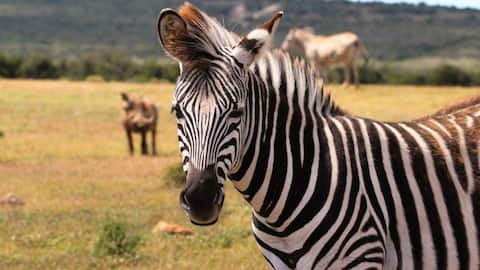International Zebra Day: 5 fascinating facts about the animal
What's the story
The zebra, with its distinctive black and white stripes, stands as one of the most iconic and enigmatic creatures on the African savannah. Beyond its eye-catching coat, the zebra boasts a range of captivating traits and behaviors that make it a subject of intrigue for wildlife enthusiasts. On International Zebra Day, let's explore these gracefull beings and their stories.
Types
Zebras are of different types
The three current varieties of zebra are the mountain zebra, the Grévy's zebra, and the plains zebra. They are distributed across various parts of Africa. These species belong to the genus Equus, which also includes horses and donkeys. Each species has different stripe patterns or widths. The smallest is the mountain zebra, which can weight up to 800 pounds (365kg approx).
Unique stripes
Their stripes are unique like fingerprints
Their distinguishing black and white stripes are akin to the uniqueness of human fingerprints. No two zebras share the same set of stripes, making their coat patterns a form of individual identification. A zebra's stripes are reddish-brown at birth, but as they develop, they gradually get darker and eventually turn black. This feature helps zebras recognize one another within their groups.
Communication skills
Zebras have different communication skills
Zebras are not silent creatures; they communicate with each other through various vocalizations. While a two-syllable cry alerts the herd to impending predators, snorts indicate satisfaction. They also express themselves through their facial expressions. Zebras greet each other by opening their mouths, extending their faces and ears. When they sense danger, they press their ears against their skulls.
Climbers
They are excellent climbers
High heights and rough terrain are home to mountain zebras. Their strong, pointed hooves enable them to climb mountains. Mountain zebras live at elevations of more than 6,500 feet (1980 meters) and use their climbing skills to move between mountains in search of water and food. Known for their agility, when threatened, zebras can reach speeds of up to 56 kilometers per hour.
Lookout for danger
They are always on the look out for danger
Zebras are highly social animals, often forming herds to protect themselves from predators. Constantly vigilant, they keep watch for signs of danger, such as the presence of hyenas, lions, leopards, or cheetahs. To alert the herd of approaching predators, they emit snorts or high-pitched cries. Even during the night, at least one member of the group remains awake to keep watch.
